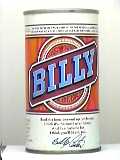


|
Q: How much is my Billy beer can worth to a can collector?
A: Actually, just about nothing. There are probably more Billy cans saved in the basements and recrooms of America than any other beer can ever made. Not only did collectors save the cans, but so did thousands of other people. The beer named after President Carters infamous brother was produced by several regional brewerys to provide distribution to the entire country. These included: Falls City of Louisville, Kentucky, Pearl of San Antonio, Texas, West End of Utica, New York, and Cold Spring of Cold Spring, Minnesota.
Q: Does the same hold true for my MASH 4077 and JR beer cans?
A: Yes. These beers came along in the early 1980's. Pearl canned both of these brands. Hanley Brewing, was listed on other MASH cans. Hanley was originally a brewery in Providence Rhode Island, but had been acquired by Falstaff before this can was issued.
Q: How can you judge a beer can's age?
A: Here are some general indicators. The earliest cans had often had step-by-step instructions printed on the back of the can to instruct drinkers on how to use the never-before-seen can opener. Some cans even show a picture of a can opener to introduce it to beer drinkers. World War II saw the sale of cans to the public practically cease, with only Olive Drab color cans being distributed to troops. Through March 1, 1950, the U.S. government required all beer cans and bottles to be printed with with the statement, "Internal Revenue Tax Paid". This supposedly would reassure the consumer that the federal government had been paid its due tax. Collectors often call these IRTP cans. Many states forced the brewers to place a tax stamp on the lib of the can. The flat top beer can and its associated can opener were replaced by cans with the built-in pull tab. This was a great advance. Since so many of these pull-tabs ended up as litter, this concept was eventually replaced by the "sta-tab" found on today's cans. Cone top cans for the most part faded away in the mid 1950's.
| Beer Can Characteristic | Era |
| Opening Instructions for Can Opener | 1935-1941 |
| Cone Top | 1935-1955 |
| Olive Drab Color | 1942-1945 |
| Internal Reveue Tax Paid | 1935-1945 |
| 8 and 16 ounce cans | 1955- |
| Flat top | 1935-1965 |
| Pull Tab | 1965-1985 |
| Stay Tab | 1985-Present |
| Gallon Beer Cans (1st generation) | 1970-1975 |
| 5 Liter Size | 1990- |
| Bar Code | 1980- |
Q. What is the rarest beer can?
A. There are a number of test beer cans of which there are only one known. The Krueger Special Beer can is certainly one of the rarest. It is especially desirable since it is widely regarded as the very first beer can.

|
Q. What gets people started collecting beer cans?
A. Many people started by saving different beers they encountered during their travels. The number of local and regional brands have shrunk. Back in 1970 a collector might of encountered the Olde Frothingslosh series in Pittsburgh and the Schmidt outdoor scene series in Minnesota. At that time there were also a large number of regional breweries that offered cans not offered nationally. The graphics on these old steel cans that were printed and later rolled from flat metal sheets surpasses what is available on todays two-piece aluminum cans.
Entering a grocery store today, one is likely to find the same brands of canned beer in Florida as they would in California.
Q.How do you convince your wife to let you fill a room with thousands of beer cans?
A. First of all, you never actually ask to fill an entire room. The savvy collector starts with a few cans in a rec room or basement. When the few cans grow into a pyramid, the only sensible thing to do is build a few shelves. After repeating this process several times you can be the proud owner of a beer can room. Having a basement helps and having an understanding wife helps even more.